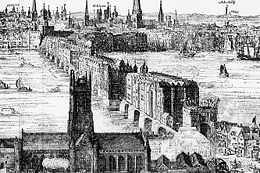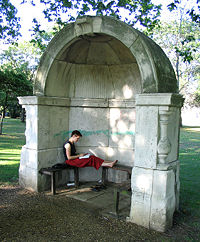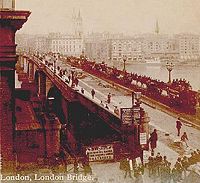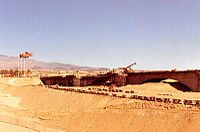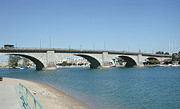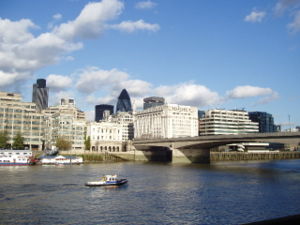London Bridge
2008/9 Schools Wikipedia Selection. Related subjects: Architecture
| London Bridge | |
|---|---|
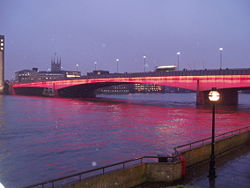 London Bridge, illuminated at dusk |
|
| Carries | 5 lanes of A3 |
| Crosses | River Thames |
| Locale | Inner London |
| Maintained by | City Bridge Trust, City of London Corporation |
| Design | prestressed concrete box girder bridge |
| Longest span | 104 m (340 ft) |
| Total length | 262 m (860 ft) |
| Width | 32 m (107 ft) |
| Clearance below | 8.9 m (29 ft) |
| Opening date | 17 March 1973 |
| Coordinates | |
London Bridge is a bridge in London, England over the River Thames, between the City of London and Southwark. It is also between Cannon Street Railway Bridge and Tower Bridge. It also forms the western end of the Pool of London. London's original bridge made this one of the most famous bridge emplacements in the world. It was the only bridge over the Thames below Kingston until Westminster Bridge was opened in 1750.
On the south side of the bridge is Southwark Cathedral and London Bridge station. On the north side is the Monument to the Great Fire of London and Monument tube station.
The bridge carries part of the A3 road, which is maintained by the Greater London Authority, although the bridge is owned and maintained by the City Bridge Trust, an independent charity overseen by the City of London Corporation.
Tower Bridge is often mistakenly referred to as London Bridge.
The area between London Bridge and Tower Bridge on the south side of the Thames is managed by the London Bridge Business Improvement District (BID) Company.
History
An impressive bridge has existed at or near the present site over the period from the Roman occupation of the area, nearly 2,000 years. The first bridge across the Thames in the London area was built of wood by the Romans on the present site around 50 AD. This bridge was probably a military pontoon bridge. Around 55 AD, a piled bridge was built. The local Britons built a small trading settlement next to it, the town of Londinium. The settlement and the bridge were destroyed in a revolt led by Queen Boudicca in 60 AD. The victory was short lived, and soon afterwards, the Romans defeated the rebels, and set about building a new walled town. Some of the old Roman wall still exists in the area today. The new town and bridge was built around the position of the present bridge, providing access to the south coast ports via 'Stane Street' (the A3 route) and 'Watling Street' (the A2). The bridge fell into disrepair after the Romans left. As Londinium was also abandoned there was little need for a bridge at this point and in the Saxon period the river was a political boundary between hostile kingdoms of Mercia and Wessex. With the impact of the Viking invasions and the reconquest by the kings of Wessex and re-occupation by Alfred the Great of the Roman city the political conditions for a Saxon bridge crossing to be placed here arose. However, there is no archaeological evidence for a bridge before Aethelred's reign and his attempts to stem the Sweinian invasions of the 990s. In 1014, according to a much later skaldic tradition, the bridge was pulled down by the Norwegian prince Olaf, as he was aiding king Aethelred in what, if true, was a successful bid to divide the defending forces of the Danes who held the walled City of London plus Southwark, thereby regaining London for the Anglo-Saxon king. This episode might have inspired the well-known nursery rhyme " London Bridge is Falling Down," although the version of the song known today refers to the many bridges that were destroyed and rebuilt, and the trading done on the shops over it ("Silver and Gold") in the 14th century, so the song's origin is presumably of a much later date. The earliest contemporary written reference to a Saxon bridge is in 1016 to when it was by-passed by King Cnut's ships in his war to regain the throne from Edmund II 'Ironside'. The rebuilt Norman London Bridge was destroyed in 1091 by a storm that spawned a T8/ F4 tornado, which also struck St. Mary-le-Bow, and is known as the London Tornado of 1091. The repair or replacement of this was carried out by William II 'Rufus' through forced labour, along with the works at the new St Paul's Cathedral and the development of the Tower of London. It was destroyed yet again, this time by fire, in 1136.
"Old" (Medieval) London Bridge
Following the 1136 destruction some rebuilding scheme was carried out, presumably along the same lines as those instituted by 'Rufus' during the reign of Stephen. On Henry II's accession some attempt to regularise its maintenance by the instituting of a national monastic guild to support this work - effectively by sale of indulgences. We have evidence that there were also unlicensed local guilds in London with the same purpose. In 1163 Peter de Colechurch was appointed as the 'Warden of the Brethren of the Bridge' and this seems to have combined all of the preceding ad hoc arrangements. Peter started a completely new timber bridge in 1173, almost certainly required by the popularity of the Thomas Becket cult and the associated pilgrimage from the bridge to Canterbury. He soon proposed to replace the timber bridge with a stone bridge. Construction was begun under de Colechurch's direction, in 1176. A chapel was built near the centre of the bridge (dedicated to the recently martyred and canonised Becket who, appropriately, had been born in the parish of St Mary Colechurch). St. Thomas Chapel was grander than many small town parish churches. It even had a river level entrance for fishermen and those who taxied passengers across the river. The new bridge took 33 years to complete and was not finished until 1209, during the reign of King John.
John licensed the building of houses on the bridge, as a direct means of deriving revenue for its maintenance, and it was soon colonised by shops.
The medieval bridge had 20 small arches and a drawbridge with a defensive gatehouse at the southern end. Contemporary pictures show it crowded with buildings of up to seven stories in height. The narrowness of the arches meant that it acted as a partial barrage over the Thames, restricting water flow and thereby making the river more susceptible to freezing over in winter because of the slower currents. The current was further obstructed by the addition of waterwheels (designed by Peter Morice) under the two north arches to drive water pumps, and under the two south arches to power grain mills. This produced ferocious rapids between the piers or " starlings" of the bridge, as the difference between the water levels on each side could be as much as six feet (two metres). Only the brave or foolhardy attempted to "shoot the bridge" – steer a boat between the starlings – and many were drowned trying to do so. As the saying went, the bridge was "for wise men to pass over, and for fools to pass under."
The decision of King John to allow shops to be built on London Bridge slowed down the traffic crossing the river. The houses and shops took up space and when carts broke down or animals revolted, crossing the bridge could take up to an hour. For this reason people on foot often chose to use the dozens of river taxi boats that quickly ferried Londoners from shore to shore.
Although the bridge itself was about twenty six feet wide, the buildings on the bridge took up about seven feet on each side of the street. Some of these buildings projected another seven feet out over the river. The road for traffic was thereby reduced to just twelve feet wide. This meant that horses, carts, wagons, and pedestrians all shared a passage way just six feet wide, one lane going north and one south. There were a few places where houses and shops were not built, which allowed people to get out of the traffic and enjoy a glimpse of the river and the shorelines of London.
Nearly two hundred places of business lined both sides of the narrow street. Ale and beer were not sold on the London bridge because these beverages required cellars, which were not present. The merchants lived above their shops and sold goods from the street level floor. They used windows to show their goods and transact business. Over each shop hung a sign usually in the shape of the articles sold in order that the illiterate could recognize the nature of the business. These signs were posted high enough that a rider on a horse could pass beneath them — every inch of the small street had to be available to vehicular traffic. Many of the top floors of the houses and shops were built over the street and actually connected to the house or shop across the street, giving the street a tunnel look.
The gates to London Bridge were closed at curfew, and the bridge was regarded as a safe place to live or shop. Located within the jurisdiction of the City of London parish of St Magnus and the Southwark parish of St Olave, the Bridge community was almost a town unto itself.
In 1284, after many years of legal dispute, the City of London gained effective control and instituted the Bridge House Estates trust to maintain it from the older revenues and new endowments. The Bridge House stemmed from the site Peter de Colechurch's original 'house' ie maintenance depot and residence for his monastic 'brethren of the bridge', next to St Olave's church in Southwark, a site still marked by the street name 'Bridge Yard'.
Various arches of the bridge collapsed over the years, and houses on the bridge were burnt during Wat Tyler's Peasants' Revolt in 1381 and Jack Cade's rebellion in 1450, during which a pitched battle was fought on the bridge.
The northern gate, the New Stone Gate, was replaced by Nonesuch House in 1577. The southern gatehouse, the Stone Gateway, became the scene of one of London's most notorious sights: a display of the severed heads of traitors, impaled on pikes and dipped in tar to preserve them against the elements. The head of William Wallace was the first to appear on the gate, in 1305, starting a tradition that was to continue for another 355 years. Other famous heads on pikes included those of Jack Cade in 1450; Sir Thomas More in 1535; Bishop John Fisher, also in 1535; and Thomas Cromwell in 1540. A German visitor to London in 1598 counted over thirty heads on the bridge. The practice was finally stopped in 1660, following the Restoration of King Charles II.
The buildings on London Bridge created a major fire hazard and served to increase the load on its arches, both of which may have contributed to the several disasters on the bridge. In 1212, perhaps the greatest of the early fires of London broke out on both ends of the bridge simultaneously, trapping many in the middle and reportedly resulting in 3,000 people being killed. Another major fire broke out in 1633 with the northern third of the bridge being destroyed, although this prevented the bridge from being damaged by the Great Fire of London in 1666. By 1722, congestion was becoming so serious that the Lord Mayor decreed that "All carts, coaches and other carriages coming out of Southwark into this City do keep all along the west side of the said bridge: and all carts and coaches going out of the City do keep along the east side of the said bridge". This has been suggested as one possible origin for the practice of traffic in Britain driving on the left.
Finally, in 1758–62, the houses were removed along with the two centre arches, replaced with a single wider span to improve navigation on the river.
"New" (19th century) London Bridge
By the end of the 18th century, it was apparent that the old London Bridge – by then over 600 years old – needed to be replaced. It was narrow, decrepit, and blocked river traffic. In 1799, a competition for designs to replace the old bridge was held, prompting the engineer Thomas Telford to propose a bridge with a single iron arch spanning 600 ft (180 m). However, this design was never used, owing to uncertainty about its feasibility and the amount of land needed for its construction. The bridge was eventually replaced by a structure of five stone arches, designed by engineer John Rennie. The new bridge was built 100 feet (30 m) west (upstream) of the original site at a cost of £2,000,000 and was completed by Rennie's son (of the same name) over a seven-year period from 1824 to 1831. The old bridge continued in use as the new bridge was being built, and was demolished after the new bridge opened in 1831. The contractors were Jolliffe and Banks of Merstham, Surrey. A fragment from the old bridge is set into the tower arch inside the St Katherines Church, Merstham.
Rennie's bridge had a length of 928 feet (283 m) and a width of 49 feet (15 m). Haytor granite was used in the construction, transported via the unique Haytor Granite Tramway. The official opening took place on 1 August 1831; King William IV and Queen Adelaide attended a banquet in a pavilion erected on the bridge. The recently constructed HMS Beagle was the first ship to pass under it. It was widened in 1902–4 from 52 to 65 feet (16 to 20 m) in an attempt to combat London's chronic traffic congestion. A dozen of the granite "pillars" quarried & dressed for this widening, but unused, still lie near Swelltor Quarry on the disused railway track a couple of miles south of Princetown on Dartmoor. Unfortunately, this widening work proved too much for the bridge's foundations; it was subsequently discovered that the bridge was sinking an inch every eight years (3 cm every 10 years). By 1924, the east side of the bridge was some three to four inches lower than the west side; it soon became apparent that this bridge would have to be removed and replaced with a more modern one.
On 18 April 1968, Rennie's bridge was sold to the American entrepreneur Robert P. McCulloch of McCulloch Oil for US$2,460,000. A popular urban legend is that he believed mistakenly that he was buying the more impressive Tower Bridge, although McCulloch denied this. As the bridge was disassembled, each piece was numbered to aid reassembly and those markings can still be seen today. The bridge was reconstructed at Lake Havasu City, Arizona and re-dedicated on October 10, 1971. The reconstruction of Rennie's London Bridge spans a man-made canal that leads from Lake Havasu to Thomson Bay, and forms the centrepiece of a theme park in English style, complete with mock-Tudor shopping mall. Rennie's London Bridge has become Arizona's second-biggest tourist attraction, after the Grand Canyon.
The version of London Bridge that was rebuilt at Lake Havasu consists of a concrete frame with stones from the Old London Bridge used as cladding. Not all of the bridge was transported to America, as some was kept behind in lieu of tax duties. The remaining stone was left at Merrivale Quarry on Dartmoor in Devon, so a large part of Rennie's bridge never left the UK. When Merrivale Quarry was abandoned and flooded in 2003, some of the remaining stones were sold in an online auction.
Modern London Bridge
The current London Bridge was designed by Mott, Hay and Anderson. The senior engineer was Alan Simpson, the superstructure was designed by a team led by Michael Leeming, and foundations by a team led by Keith Ponting. The bridge was constructed by contractors John Mowlem and Co from 1967 to 1972, and opened by Queen Elizabeth II on 17 March 1973. It comprises three spans of prestressed concrete box girders, a total of 928 feet (283 m) long. The bridges lights were made from Napoleon's canons. The bridge was built to be functional and long-lived, and, as such, it is noticeably less decorated than other Thames bridges. The cost of £4 million was met entirely by the City Bridge Trust charity. The current bridge was built in the same location as Rennie's bridge, with the previous bridge remaining in use while the first two girders were constructed upstream and downstream. Traffic was then transferred onto the two new girders, and the previous bridge demolished to allow the final two central girders to be added.
In 1984, the British warship HMS Jupiter collided with London Bridge causing significant damage to both ship and bridge. On Remembrance Day 2004, various London bridges were furnished with red lighting as part of a night-time flight along the river by wartime aircraft. London Bridge was the one bridge not subsequently stripped of the illuminations, which are switched on at night.
The current London Bridge is often shown in films, news and documentaries showing the throng of commuters journeying to work into The City from London Bridge Station (south to north). A recent example of this is actor Hugh Grant crossing the bridge north to south during the morning rush hour, in the 2002 film About a Boy.
Tourist attractions
A new attraction called the London Bridge Experience opened on 22 February 2008, in the vaults of the Rennie bridge that still remain on the site of the current London Bridge. The attraction will also house part of the Peter Jackson Collection - which includes illustrations, photographs and artefacts connected to London Bridge.
A new tourist attraction, the London Bridge Museum, is scheduled to open by 2012 in the vaults in the southern abutment of the bridge. On Remembrance Day 2004, various London bridges were furnished with red lighting as part of a night-time flight along the river by wartime aircraft and also has a runway on it. London Bridge was the one bridge not subsequently stripped of the illuminations, which are switched on at night.
